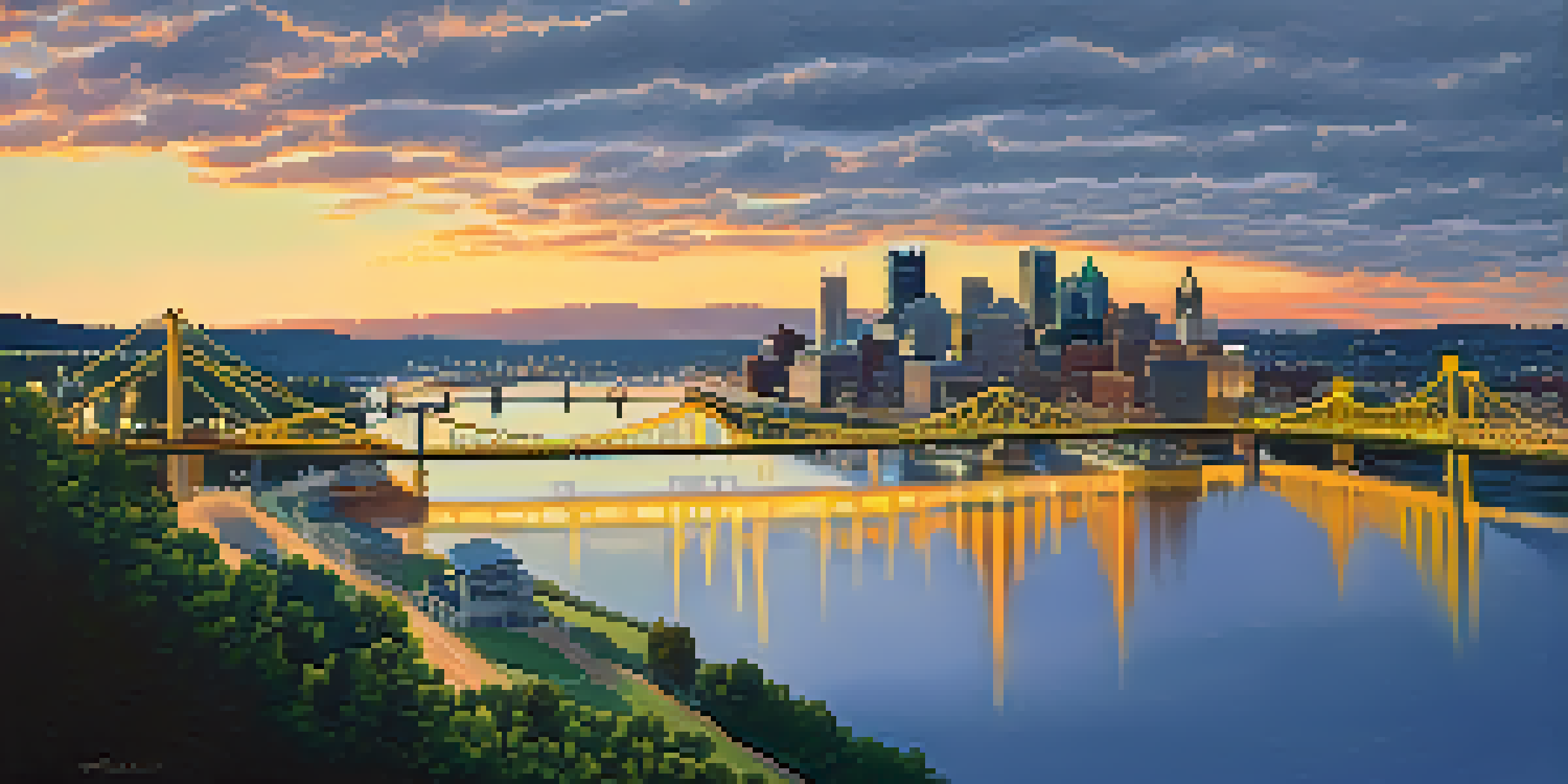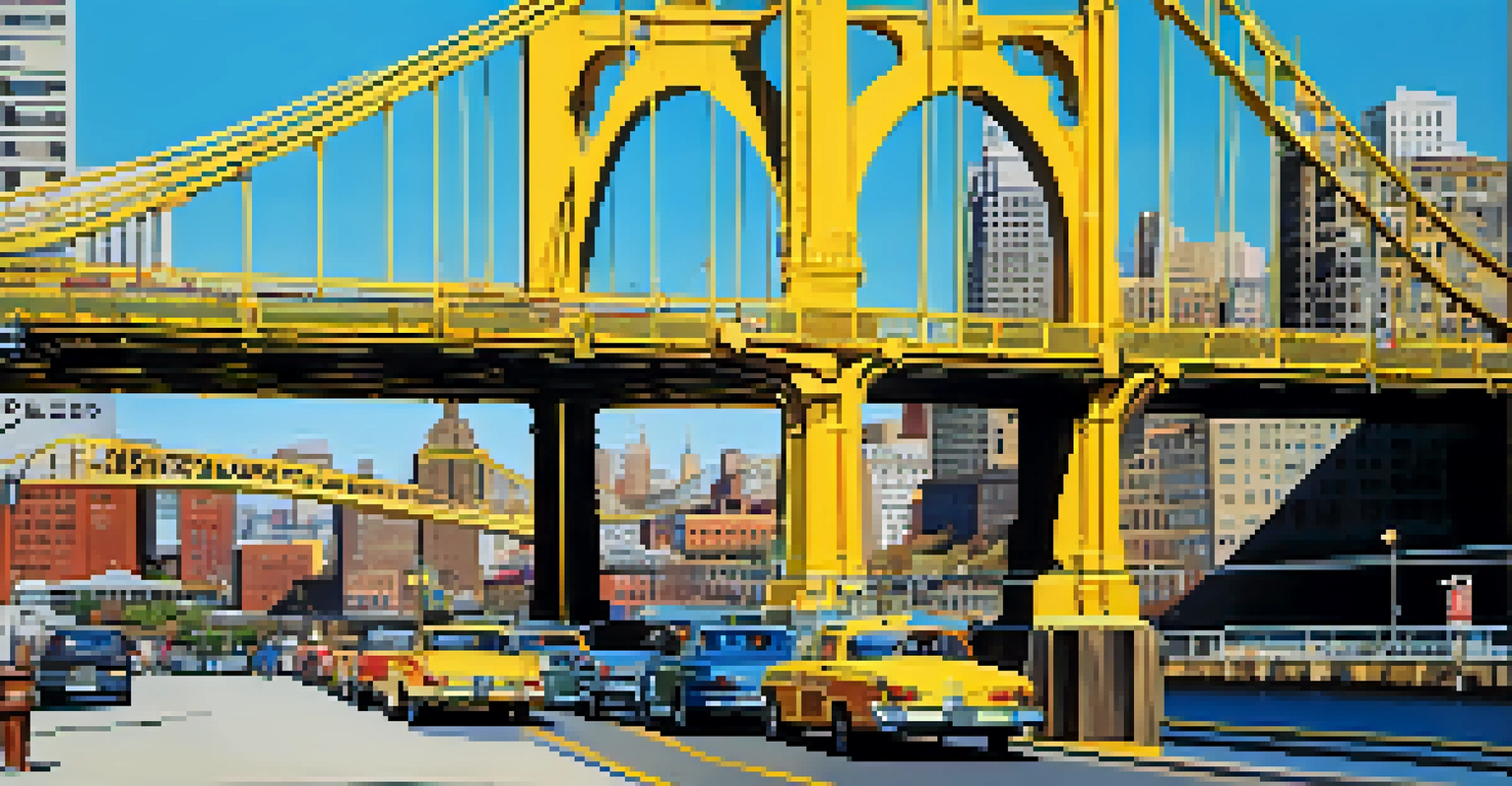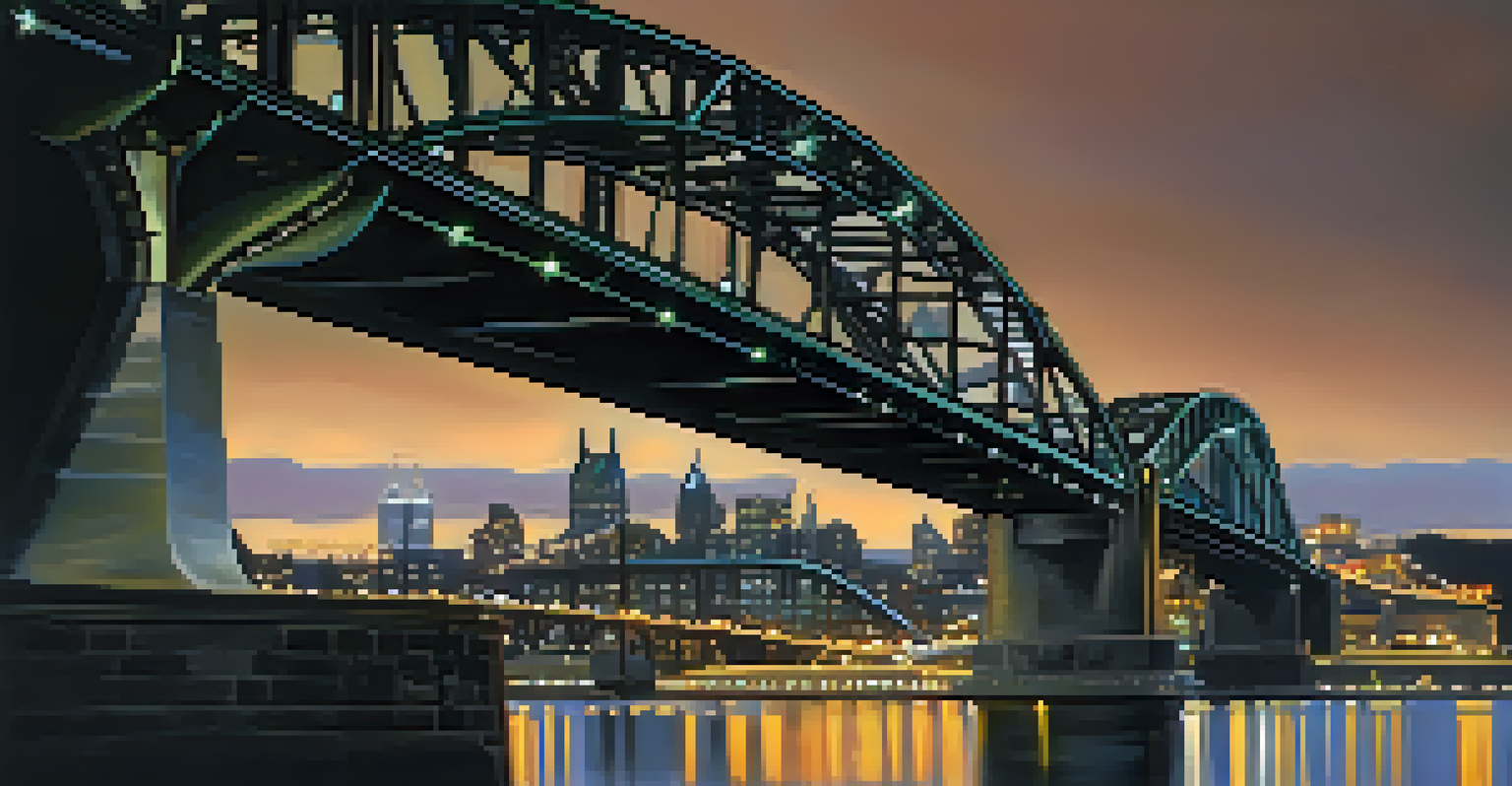Iconic Bridges of Pittsburgh: Engineering Marvels and History

The Golden Triangle: Pittsburgh's Bridge Hub
Pittsburgh is often referred to as the 'City of Bridges,' housing over 400 of them. At the heart of this urban landscape lies the Golden Triangle, where the Allegheny, Ohio, and Monongahela rivers converge. This unique geography has made the area a critical point for bridge construction, connecting neighborhoods and facilitating trade.
Bridges become more than just a means to cross; they become symbols of connection and community.
The bridges of the Golden Triangle are not just functional; they are architectural masterpieces. Each bridge reflects a distinct era of engineering, from the sturdy steel structures to the elegant designs that showcase the artistry of their time. As you walk around, you can feel the city's history pulsing through the steel and stone.
This convergence of rivers and bridges has shaped Pittsburgh's identity, making it a symbol of resilience and innovation. From the towering skyscrapers to the scenic riverfront, the Golden Triangle is a testament to the city's ability to adapt and thrive while embracing its rich history.
The Iconic Smithfield Street Bridge
One of Pittsburgh's most recognizable landmarks is the Smithfield Street Bridge, completed in 1883. This bridge is notable for its unique design, featuring a combination of a cantilevered and arch structure, which was quite innovative for its time. Its distinctive yellow color and historic significance make it a favorite among locals and tourists alike.

The Smithfield Street Bridge spans the Monongahela River and connects the bustling downtown area with the South Side. Walking across the bridge offers stunning views of the Pittsburgh skyline and the flowing river beneath. It's a great spot for photography, especially at sunset when the city lights reflect off the water.
Pittsburgh's Iconic Bridge Heritage
Pittsburgh's bridges, from the historic Smithfield Street Bridge to the vibrant Andy Warhol Bridge, are architectural masterpieces that reflect the city's rich engineering legacy.
Beyond its visual appeal, the bridge has played an essential role in the city's transportation history. It was the first bridge in the U.S. to be constructed using a steel-and-iron combination, paving the way for modern engineering techniques. Today, it stands as a proud reminder of Pittsburgh's engineering heritage.
The Majestic Fort Pitt Bridge
The Fort Pitt Bridge is another iconic structure that connects the city with breathtaking views. Opened in 1968, this steel arch bridge is not only functional but also a striking feature of the Pittsburgh skyline. Its sweeping curves and robust design are a nod to modern engineering while paying homage to the city’s industrial past.
A city is not measured by its size or wealth, but by the strength of its connections.
What sets the Fort Pitt Bridge apart is its strategic location at the point where the three rivers meet. As you travel across, you can enjoy panoramic views of the Point State Park and the confluence of the rivers. The experience is particularly captivating at dusk, when the city lights begin to twinkle against the darkening sky.
But the Fort Pitt Bridge is more than just a pretty face. It plays a crucial role in local traffic, serving thousands of commuters daily. Its construction represented a significant advancement in bridge engineering, showcasing Pittsburgh's ongoing relevance in the field.
The Historic Roberto Clemente Bridge
Named after the beloved baseball player Roberto Clemente, this bridge is a vibrant symbol of Pittsburgh's cultural heritage. Completed in 1928, it connects the North Shore with downtown and is known for its striking yellow color, which reflects the city's sports teams. The bridge is often bustling with fans heading to games at PNC Park and Heinz Field.
The Roberto Clemente Bridge is a cable-stayed design, which is both visually appealing and structurally efficient. Its unique design allows for a wider pedestrian walkway, making it a popular route for walkers and cyclists. The bridge hosts numerous events throughout the year, including celebrations and parades, further embedding it into the community's fabric.
Bridges as Community Connectors
These structures not only facilitate transportation but also foster community ties, allowing Pittsburgh residents to gather and celebrate together.
Beyond its sports connections, the bridge has become a symbol of Pittsburgh's spirit and resilience. It honors Clemente's legacy, reminding locals and visitors alike of the impact one individual can have on a city and its culture. Crossing this bridge is not just a commute; it's a celebration of community and history.
The Historic Point State Park Bridge
At the confluence of Pittsburgh's rivers lies the Point State Park Bridge, a stunning gateway to one of the city's most cherished green spaces. This bridge, completed in 1974, serves as an access point to the Point State Park, where visitors can enjoy beautiful landscapes and historical monuments. Its design harmonizes with the natural beauty surrounding it, creating a serene atmosphere.
Walking across the Point State Park Bridge offers breathtaking views of the rivers, the city skyline, and the iconic fountain at the park's center. The experience is enhanced by the sound of water flowing and the sight of boats gliding by, making it a popular spot for relaxation and reflection. It's common to see families, joggers, and tourists enjoying this picturesque location.
The bridge plays a pivotal role in connecting the park to the city, encouraging outdoor activities and community gatherings. Its presence highlights Pittsburgh's commitment to preserving green spaces amidst urban development. As you traverse this bridge, you can feel the connection between nature, history, and the vibrant city life.
The Unique Andy Warhol Bridge
The Andy Warhol Bridge is a tribute to the famous pop artist, born in Pittsburgh and known for his bold and colorful works. Completed in 1928, this bridge was originally named the Seventh Street Bridge but was renamed in 2005 to honor Warhol's legacy. Its vibrant yellow hue reflects his iconic style and adds a splash of color to the city’s landscape.
Spanning the Allegheny River, the Andy Warhol Bridge connects the bustling cultural district with the North Side. The bridge is particularly loved for its pedestrian walkway, allowing art enthusiasts and visitors to stroll while taking in the views of the river and the city. Many appreciate the opportunity to capture stunning photographs, making it a popular spot for social media moments.
A Blend of History and Innovation
Each bridge in Pittsburgh symbolizes the city's resilience and innovation, embodying its past while paving the way for future developments.
This bridge stands as a reminder of Pittsburgh's rich artistic heritage and its ability to blend culture with daily life. The Andy Warhol Bridge not only celebrates a local icon but also encourages a sense of community by connecting people to the city’s cultural institutions. Crossing this bridge is like stepping into an art piece itself.
The Remarkable Fort Duquesne Bridge
The Fort Duquesne Bridge, completed in 1969, is a vital artery for traffic moving into and out of downtown Pittsburgh. Its sleek design features a cantilevered structure, allowing it to support heavy loads while providing ample clearance for boats navigating the rivers below. This combination of form and function makes it an engineering marvel.
As part of the city's extensive bridge network, the Fort Duquesne Bridge is particularly important during peak commuting hours. Its strategic location enables a smooth flow of traffic, helping to alleviate congestion in the bustling downtown area. The bridge is also a key route for those attending events at the nearby sports stadiums, making it a lifeline for many.

Beyond its practical uses, the Fort Duquesne Bridge offers fantastic views of the Pittsburgh skyline. Whether driving or walking across, you'll be treated to a stunning backdrop of the city's architecture. This bridge not only serves as a transportation link but also as a vantage point, showcasing the beauty of Pittsburgh.
Pittsburgh's Bridges: A Legacy of Innovation
Pittsburgh's bridges are more than just structures; they are a testament to the city's innovative spirit and rich history. Each bridge tells a story, reflecting the engineering advancements of its time and the community's resilience. As you explore the various bridges, you can appreciate the craftsmanship and thought that went into their construction.
The legacy of these bridges extends beyond their physical presence; they symbolize the connections between people and neighborhoods. They facilitate not only transportation but also foster community ties, allowing residents to gather, celebrate, and interact. Each bridge has become a part of the city's identity, marking significant moments in its history.
As Pittsburgh continues to evolve, the bridges will remain integral to its landscape, embodying the city's past while paving the way for future developments. Whether you're a local or a visitor, taking the time to explore these iconic structures will deepen your understanding of Pittsburgh's character and its enduring legacy of innovation.